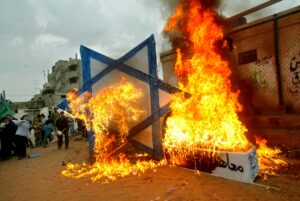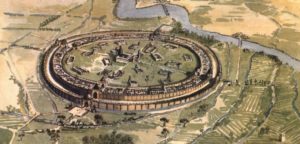Where does the story of Gaza begin? In this region, history — or histories, given that here there is no such thing as a singular history — is serially and violently contested. “Anyone who tells a story knows that most of the work of the telling is done in the choice of where the story begins,” my old professor Ian Lustick, author of several books about Israel, wrote recently. His point was that if your story begins on 7 October 2023, it is a straightforward tale, in which barbarians slaughter the innocents before the latter, flying the flag of the civilised world, launch their counterstrike, mete out retribution and defeat the aggressors.
Start the story at a different moment in time — 1948, say, when the grandparents of today’s Gazans were living in the area, now southern Israel, where Hamas terrorists committed their atrocities — and the crystalline certainties of the scenario above take on a different light.
But there are more than two options. We could begin our story much earlier than 1948, perhaps when the name Gaza was recorded for the first time: during the reign of the mighty, empire-building Thutmose III, 1,479–1,425 BC. By this time, Gaza had already been under the rule of the Pharaohs for several decades. The long view quickly reveals that contest is a constant in Gaza’s history. Wars surge up at intervals in great, seismic eruptions, before the territory settles into an equilibrium which in turn is shattered by another external invader.
Much of this turbulence can be attributed to Gaza’s strategic location. Hemmed in between the Mediterranean and the Sinai and Negev deserts, this coastal oasis has long been a desirable waypoint on the trade routes that criss-crossed the arid region. Both the Greek historian Diodorus Siculus, in the 1st century BC, and the Arab geographer Al Muqaddasi in the 10th century AD, commented on its beauty and enviable location. Critically, as the last point before a desert crossing, it was also an essential stopping place for conquerors looking either east from Egypt or west from the Levant. All roads of conquest ran through Gaza.
Enter stage left, from the 12th century BC, among the most historically compelling of Gaza’s many occupiers: the pagan Philistines of Philistia, etymological forefathers of the Muslim Palestinians of Palestine. And here, as the Philistines came to blows with the Jewish tribes of the interior over access to the coast, arose the earliest signs of the conflict that continues 32 centuries later between the Palestinians and Israelis.
This was the Gaza of the Bible, in which the Israelite warrior Samson was chosen by the Old Testament God to rescue Israel from the Philistines. Tricked by Delilah into revealing the secret of his strength, Samson was eventually undone, his eyes gouged out before he was imprisoned in Gaza and put to work turning a massive millstone around and around in an endless ordeal. But he had the bitter last laugh, as he pulled down the Philistine temple on himself and his persecutors, killing everyone.
This apocalyptic vision of going round and round in circles before wreaking death and mutually assured destruction endures as the defining narrative of Israel and Gaza. Old Testament smiting becomes 21st-century Israeli airstrikes and Palestinian rockets, the violence circular and never-ending.
Gaza has been completely destroyed and emptied of its inhabitants before. Alexander the Great besieged the city in 332 BC. When it refused to surrender, his forces stormed its defences, put its men to the sword, and sold its children into slavery. The Hasmonean siege in 96 BC was another orgy of slaughter and destruction, this time launched by the Jewish king Alexander Jannaeus, ruler of Judaea, to seize Gaza from the Greeks. After these explosions of violence, the transfer of Gaza to Roman rule in 63 BC was comparatively peaceful, but after Rome officially switched to Christianity in 380, and the Bishop Porphyrius became bishop of Gaza in 395, he led a mob to loot and sack a city which had remained traditionally hostile to the followers of Christ. The city’s pagan gods and temples were destroyed in a fundamentalist frenzy. Last Thursday, 17 centuries later, St Porphyrius got his comeuppance when an Israeli airstrike shattered the church, the oldest in Gaza, that bore his name.
For a time, Byzantine prosperity succeeded the Pax Romana, before wars with the Persians brought renewed strife. While these two elderly leviathans slugged it out, in surged a new, nimble and faith-filled force. Muslim Arabs conquered Gaza in 637, only five years after the Prophet Mohammed’s death; a flurry of Levantine cities, including Damascus and Jerusalem, were taken during the same campaign. In time, Gaza became a significant intellectual and commercial centre — before an Arab civil war in 796 ruined it altogether. That Muslim-on-Muslim conflict was just one among many early harbingers of the deep intra-Arab tension and disunity — Arabs call it fitna — which would bedevil Middle Eastern politics from the 20th century. But after the devastation of the Crusader conquests, Saladin restored Muslim pride and prosperity to Gaza, ushering in a long period of Mamluk and then Ottoman rule, which persisted until 1917.
But so many of these earlier wars and conquests seem like here-today-gone-tomorrow disturbances when compared with the devastation of today. Ancient disputes have, in the past century or so, sharpened into arguably the world’s most tragically intractable and bloody conflict, in which victims are aggressors and aggressors victims.
Lustick chose 1948 to begin his summary of the current conflict, but one could equally start a few decades earlier, with the British seizure of Palestine from the ruins of the Ottoman Empire in 1917. That moment ushered in a new iteration of a conflict that has arguably never ended. Energetically lobbied by the Zionist movement, which wanted a Jewish homeland, Britain made a fateful decision that year. London’s Balfour Declaration which — in the words of the writer Arthur Koestler “one nation solemnly promised to a second nation the country of a third”— promised “a national home for the Jewish people” in the land the Biblical God had promised to Israel. Mass Jewish immigration followed, accelerated by the rise of the Nazis: around 250,000 Jews came to Mandate Palestine between 1929 and the outbreak of the Second World War.
Hounded out of Palestine by the Jewish Irgun and Stern Gang terrorists in 1947, the British were unable to deliver on the second principle of the declaration: that “nothing shall be done which may prejudice the civil and religious rights of existing non-Jewish communities in Palestine”. Much — Palestinians would say everything — was then done by Israel to prejudice Palestinian rights. All-out conflict in 1948 led to triumph and statehood for Israel, and wholesale dispossession and disaster — the notorious nakba — for the Palestinians. Around 750,000 fled into exile or were expelled — mostly to the West Bank, controlled by Jordan, or Gaza, then in Egyptian hands. Prevented from either entering Egypt proper, which did not want to take in such enormous numbers, or returning to their homes in Israel, overnight they became stateless refugees.
In 1947, the UN’s partition plan, rejected by the Arabs, had proposed a Jewish state occupying 55% of the country. By 1949, Israel controlled 78% of Mandatory Palestine, leaving the Arabs occupying West Bank and Gaza, which together represented just 22% of the original territory.
Our story of Gaza takes another tragic turn at this point. Following its victory in the Arab-Israeli war of 1967, Israel occupied Gaza, prefiguring a rise of Jewish settlements, illegal under international law, in the territory. Tensions escalated to the boiling point of the 1987 intifada, violent protests which killed more than 2,000 and which came to be emblematic — as Gaza itself has become — of Palestinian resistance. Further intifadas — killing more than 4,000 in the 2000s, and 273 in 2015–16 — surged out of the failure of the long-awaited 1993 Oslo accords to bring peace.
Meanwhile, into Gaza’s political arena stormed Hamas, making mincemeat of its secular rival Fatah. Hamas has no interest in politics or development. It clings to the dream of the destruction of Israel and has risen to power and prominence to become the face of Palestinian resistance in Gaza and beyond. As Ian Black writes in Enemies and Neighbours, a history of Israel and Palestine from 1917–2017, the Gaza Strip is “a permanent, festering — and often violent — reminder of the unresolved conflict between Arabs and Jews in the Holy Land”.
Bald statistics confirm the reality of its immiserated population. Of the 2.2 million Gazans, 68% are refugees. The poverty rate is 61%, unemployment over 46%. Over 73% of households receive humanitarian assistance, with more than 68% citing it as the main source of their income. This is what Palestinians mean when they talk about the daily violence of life under a blockade which has been in force since Hamas took power in 2007, leaving most Gazans shut in, their airspace and coastline controlled by Israel. There is no question of freedom or autonomy. This is fertile territory for resistance and hatred.
And when Gazans consider the future, it’s hard to discern a ray of hope. They can hardly look to the occupied West Bank for a model settlement. Abandoning the armed struggle, recognising Israel and accepting 22% of historic Palestine has brought the West Bank Palestinians little in the way of dividends. Its 87-year-old “leader”, Mahmoud Abbas, head of the corrupt, enfeebled and incompetent Palestinian Authority, is known derisively in some Israeli circles as the mayor of Ramallah. Meanwhile, the two-state solution is dead and the extremists in power on both sides are dancing on its grave.
“Peace between Israel and Palestine can assume neither meaning nor substance except in Gaza, which will be both the foundation and the keystone,” wrote Jean-Pierre Filiu, Professor of Middle East Studies at Paris’s Sciences Po in 2012. A decade later, Gaza finds itself once again a cauldron of conflict. Khaled, a Palestinian friend, messages me. He fears the worst for this refuge of refugees. “For me, the unbearable human suffering experienced by Gaza is made worse by the real threat of a repeat of the historical traumatic displacement of Palestinians that Gaza embodies.”
Today, as Gaza crumbles beneath the relentless barrage of strikes, braced for another deadly invasion, a new story will begin. One can only hope, in the words of the late Lebanese poet Nadia Tuéni, writing about her beloved Beirut in 1986, that Gaza will survive: “Elle est mille fois morte, mille fois revécue.”
Disclaimer
Some of the posts we share are controversial and we do not necessarily agree with them in the whole extend. Sometimes we agree with the content or part of it but we do not agree with the narration or language. Nevertheless we find them somehow interesting, valuable and/or informative or we share them, because we strongly believe in freedom of speech, free press and journalism. We strongly encourage you to have a critical approach to all the content, do your own research and analysis to build your own opinion.
We would be glad to have your feedback.
Source: UnHerd Read the original article here: https://unherd.com/




